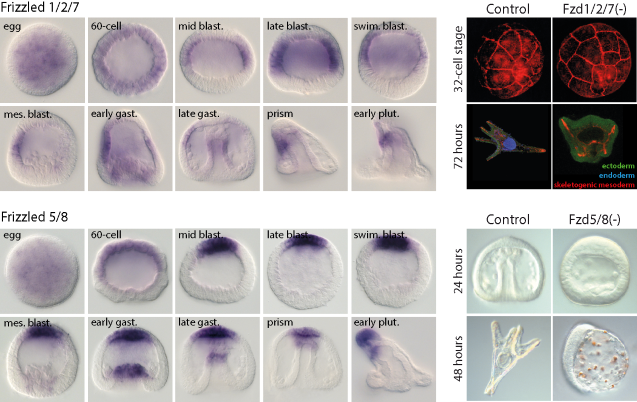Wnt signaling is one of the most fundamental intercellular signaling systems of multicellular animals and is required for the regulation of numerous biological processes both during embryogenesis and in adults. Within a target cell, the intercellular Wnt signaling system can trigger several different intracellular signal transduction cascades, including three main ones: the canonical Wnt/b-catenin pathway and the non-canonical planar cell polarity and calcium pathways. As of today, most studies on Wnt signaling have focused on the roles of these three intracellular pathways and their cross talk during development. In contrast, virtually nothing is known about the mechanisms underlying the recognition and binding specificities of individual Wnt proteins to their cognate Frizzled (Fzd) receptors and about the molecular processes leading to the activation, by a given ligand-receptor couple, of a particular intracellular Wnt pathway. This lack of knowledge, in turn, also hampers the characterization of the global biological responses triggered by Wnt signaling, both on a genomic and developmental level.

In the EvoInSiDe team, we are addressing this shortcoming using both genomic and embryological approaches in comparative analyses with different animal model systems. Our current investigations include the characterization of the Wnt and Fzd complements from a large variety of different metazoan animals in an effort to retrace the evolutionary history of the Wnt and Fzd families. This project makes use of bioinformatic approaches, such as phylogenetic analyses, genome-wide synteny screens as well as ancestral sequence reconstruction. In parallel, we are also studying the roles of Wnt signaling during development, chiefly in sea urchins and amphioxus. In sea urchins, we have, for example, already characterized the spatiotemporal expression patterns of all Wnt ligands and Fzd receptors from the European species Paracentrotus lividus. We have further established that a specific Wnt/Fzd couple (Wnt6 and Frizzled1/2/7) is required, in this species, for the activation of canonical Wnt/b-catenin signaling in a subset of vegetal blastomeres to establish endodermal cell fate and that another Fzd receptor (Frizzled5/8) controls the initiation of gut invagination, likely through the activation of the non-canonical planar cell polarity pathway.

Our goal is now to identify the totality of Wnt/Fzd couples forming during sea urchin and amphioxus development and to characterize their functions, including both the genomic responses triggered and their developmental readouts in embryos and larvae. This project will thus reveal a trove of information on the most fundamental aspects of Wnt signaling: its activation, its target genes, and its biological roles during development. Comparisons of these results with available information from other animal models will ultimately allow the establishment of an evolutionary roadmap for the diversification of the Wnt signaling system in multicellular animals.

Laboratoire de Biologie du développement UMR 7009
Cette UE se déroule sur 2 semaines et a lieu au laboratoire de Biologie du Développement de Villefranche -sur-Mer (LBDV). Elle inclut l’examen de l’UE d’analyse scientifique (5V089) suivie par les étudiants de la spécialité de Biologie du Développement.
Durant la 1ère semaine, les étudiants participent à des ateliers et des rencontres avec les chercheurs du laboratoire.
Durant la 2ème semaine, les étudiants sont répartis dans les équipes pour y réaliser un mini projet qu’ils présentent le dernier jour du cours. Le cours est donné en anglais pour tout ou partie.
Modalités d’évaluation
Présentation orale du mini-projet (binôme, 100 %)
UE en anglais (partiellement ou totalement)
Master BMC, S3, 6 ECTS
Code UE: 5V200
Responsable de l’UE: Carine BARREAU (MCU): carine.barreau [at] obs-vlfr.fr
Cette UE permet aux étudiants de 1ère année de Master de passer 2 semaines à l’Observatoire Océanologique de Villefranche-sur-Mer. Le cours est obligatoire pour les étudiants du Master Biologie Intégrative, parcours Biologie et Bioressources Marines (BBMA) tandis qu’il peut être choisi en option par les étudiants du Master Biologie Moléculaire et Cellulaire (BMC). Les étudiants participent à des ateliers de présentation des organismes marins utilisés par les équipes de recherche du laboratoire (LBDV) et apprennent à les manipuler au cours de travaux pratiques dont les thématiques vont de la Biologie du Développement fondamentale à la toxicologie appliquée.
Modalités d’évaluation
Analyse d’article et présentation orale (50%)
Compte-rendu écrit de TP (50%)
UE partiellement en anglais
Master BIP, S2, 6 ECTS
Code UE: 4B022 (ouverte au Master BMC)
Responsable de l’UE: Carine BARREAU (MCU): carine.barreau [at] obs-vlfr.fr
Cette UE complémentaire se déroule sur 2 semaines et permet aux étudiants de découvrir les différents aspects (métiers & recherche) de l’Observatoire Océanologique de Villefranche-sur-Mer (OOV). Ateliers et journal clubs sont organisés afin que les étudiants mettent en pratique leurs connaissances théoriques en biologie et développent leur capacité de communication scientifique en français et en anglais.